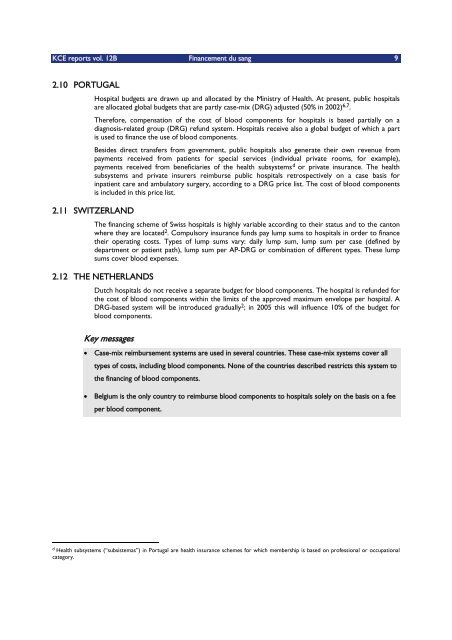Télécharger le rapport (160 p.) - KCE
Télécharger le rapport (160 p.) - KCE
Télécharger le rapport (160 p.) - KCE
Create successful ePaper yourself
Turn your PDF publications into a flip-book with our unique Google optimized e-Paper software.
<strong>KCE</strong> reports vol. 12B Financement du sang 9<br />
2.10 PORTUGAL<br />
Hospital budgets are drawn up and allocated by the Ministry of Health. At present, public hospitals<br />
are allocated global budgets that are partly case-mix (DRG) adjusted (50% in 2002) 6,7 .<br />
Therefore, compensation of the cost of blood components for hospitals is based partially on a<br />
diagnosis-related group (DRG) refund system. Hospitals receive also a global budget of which a part<br />
is used to finance the use of blood components.<br />
Besides direct transfers from government, public hospitals also generate their own revenue from<br />
payments received from patients for special services (individual private rooms, for examp<strong>le</strong>),<br />
payments received from beneficiaries of the health subsystems d or private insurance. The health<br />
subsystems and private insurers reimburse public hospitals retrospectively on a case basis for<br />
inpatient care and ambulatory surgery, according to a DRG price list. The cost of blood components<br />
is included in this price list.<br />
2.11 SWITZERLAND<br />
The financing scheme of Swiss hospitals is highly variab<strong>le</strong> according to their status and to the canton<br />
where they are located 2 . Compulsory insurance funds pay lump sums to hospitals in order to finance<br />
their operating costs. Types of lump sums vary: daily lump sum, lump sum per case (defined by<br />
department or patient path), lump sum per AP-DRG or combination of different types. These lump<br />
sums cover blood expenses.<br />
2.12 THE NETHERLANDS<br />
Dutch hospitals do not receive a separate budget for blood components. The hospital is refunded for<br />
the cost of blood components within the limits of the approved maximum envelope per hospital. A<br />
DRG-based system will be introduced gradually 2 ; in 2005 this will influence 10% of the budget for<br />
blood components.<br />
Key messages<br />
Case-mix reimbursement systems are used in several countries. These case-mix systems cover all<br />
types of costs, including blood components. None of the countries described restricts this system to<br />
the financing of blood components.<br />
Belgium is the only country to reimburse blood components to hospitals so<strong>le</strong>ly on the basis on a fee<br />
per blood component.<br />
d Health subsystems ( subsistemas ) in Portugal are health insurance schemes for which membership is based on professional or occupational<br />
category.

















